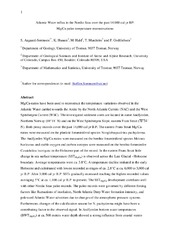| dc.contributor.advisor | Hald, Morten | |
| dc.contributor.author | Sørensen, Steffen Aagaard | |
| dc.date.accessioned | 2011-03-30T10:21:47Z | |
| dc.date.available | 2011-03-30T10:21:47Z | |
| dc.date.issued | 2011-03-22 | |
| dc.description.abstract | The overall objective for this PhD-study was to further advance the understanding of the oceanographic variability and development in the Nordic Seas during the Late Glacial and the Holocene and towards the present. The focus is specifically on the poleward Atlantic Water advection along the continental margins of Norway, into the SW Barents Sea and along the West Spitsbergen slope. Four high resolution sediment cores retrieved from northern continental shelve allowed examination of spatial and temporal oceanographic and environmental variability and elucidation of underlying forcing mechanisms. The sediment cores were investigated using several paleoceanographic proxies. These include planktic and benthic foraminiferal fauna distributions, measurements of stable isotopes (δ18O, δ13C) on foraminiferal tests and transfer function SST reconstructions based on planktic foraminifer species counts. Grain size analysis, IRD counts, clay mineral analysis and chemical analysis of bulk sediment carbon content were also used. Additionally the relatively new paleothermometer, the Mg/Ca-ratio, was applied on planktic and benthic foraminifera to test and examine its applicability in Subarctic and Arctic environmental settings. The Mg/Ca-ratios were used to constrain reconstructions of sea surface and bottom water temperatures. Furthermore, Mg/Ca-ratios combined with isotopic measurements performed on the same foraminiferal species were used for quantization of past oceanic salinity changes.
Weak Atlantic Water influence was observed briefly at around 18,700 and after 15,000 cal yr B.P. in the SW Barents Sea indicating an early deglaciation of Ingøydjupet. Sub surface Atlantic Water inflow was observed from the beginning of the records (at 14,000 cal yr B.P.) in both the eastern Fram Strait and in Andfjorden. Atlantic Water influx was diminished during the Younger Dryas at all investigated core sites. Strong inflow of Atlantic Water resulted in emergence at the surface during the glacial – interglacial transition. The emergence had a south-north time delay of ca. 1,000 years which probably can be ascribed to increasing influence from a lingering pool of sea-ice and melt water towards the north. Reconstructed temperatures of Atlantic Water entering the Arctic Ocean through the eastern Fram Strait show a ~2°C warming during the last ca. 100 years. This warming is unprecedented over the past 2000 years and is probably linked to the Arctic amplification of global warming. | en |
| dc.description.doctoraltype | ph.d. | en |
| dc.description.sponsorship | Trainee School in Arctic Marine Geology and Geophysics (AMGG); University of Tromsø, Department of Geology; Research Council of Norway; | en |
| dc.description | Papers 1, 2 and 5 are not available in Munin due to publishers' restrictions: <br/>1. S. Aagaard-Sørensen, K. Husum, M. Hald, J. Knies: 'Paleoceanographic development in the SW Barents Sea during the Late WeichselianeEarly Holocene transition',Quaternary Science Reviews 29 (2010) 3442-3456. Paper available at <a href=http://dx.doi.org/10.1016/j.quascirev.2010.08.014>http://dx.doi.org/10.1016/j.quascirev.2010.08.014</a> <br/>2. J. Junttila, S. Aagaard-Sørensen, K. Husum and M. Hald: 'Late Glacial–Holocene clay minerals elucidating glacial history in the SW Barents Sea', Marine Geology 276 (2010) 71–85. Paper available at <a href=http://dx.doi.org/10.1016/j.margeo.2010.07.009> http://dx.doi.org/10.1016/j.margeo.2010.07.009</a> <br/>5. Spielhagen, R. F.,Werner, K., Aagaard-Sørensen, S., Zamelczyk, K., Kandiano,E., Budeus, G., Husum, K., Marchitto, T. and Hald, M.:'Enhanced Modern Heat Transfer to the Arctic by Warm Atlantic Water', SCIENCE(2011), 331, 450-453. Paper available at <a href=http://dx.doi.org/10.1126/science.1197397> http://dx.doi.org/10.1126/science.119739</a> | en |
| dc.identifier.isbn | 978-82-8236-026-5 | |
| dc.identifier.isbn | 978-82-8236-027-2 | |
| dc.identifier.uri | https://hdl.handle.net/10037/3007 | |
| dc.identifier.urn | URN:NBN:no-uit_munin_2738 | |
| dc.language.iso | eng | en |
| dc.publisher | Universitetet i Tromsø | en |
| dc.publisher | University of Tromsø | en |
| dc.rights.accessRights | openAccess | |
| dc.rights.holder | Copyright 2011 The Author(s) | |
| dc.rights.uri | https://creativecommons.org/licenses/by-nc-sa/3.0 | en_US |
| dc.rights | Attribution-NonCommercial-ShareAlike 3.0 Unported (CC BY-NC-SA 3.0) | en_US |
| dc.subject | VDP::Mathematics and natural science: 400::Geosciences: 450::Marine geology: 466 | en |
| dc.subject | VDP::Matematikk og Naturvitenskap: 400::Geofag: 450::Marin geologi: 466 | en |
| dc.subject | Late Glacial-Holocene | en |
| dc.subject | northern continental shelves | en |
| dc.subject | planktic foraminifera | en |
| dc.subject | stable isotopes | en |
| dc.subject | Mg/Ca ratios | en |
| dc.title | Late Glacial – Holocene climate variability and sedimentary environments on northern continental shelves
Zonal and meridional Atlantic Water advection | en |
| dc.type | Doctoral thesis | en |
| dc.type | Doktorgradsavhandling | en |


 English
English norsk
norsk


